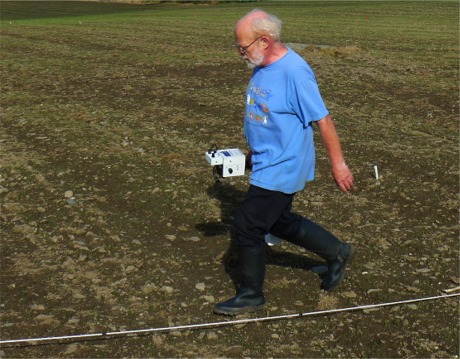|
|
Archaeologists discover early
monastery
02.09.12
by Linda McGrory
ARCHAEOLOGISTS exploring links between early
medieval monasteries in Ireland, Britain and
mainland Europe have discovered important evidence
of a settlement in Inishowen.
The team of tutors and students from the University
of Sunderland, made their discovery last week during
a 10-day field trip to Culdaff.
Using the latest in hand-held geophysical mapping
equipment, they discovered a circular, boundary
wall, some 100-metres in diameter, buried
underground in fields at Carrowmore, Culdaff. The
location of the find has two high crosses and is
already known as an early Christian site circa the
6th Century. However, the latest discovery provides
some of the first ‘physical proofs’ that an early
medieval monastery existed at the spot. |
 |
|
Geoffrey Taylor uses a fluxgate
gradiometer to map out the site of a monastic
settlement at Carrowmore, Culdaff. (Photo: Bernician
Study Group) |
Archaeologist and group
co-leader, Colm O'Brien, said the discovery was
"beyond (their) wildest dreams".
"We were awarded capital funding of around 10,000
euro from our university to purchase a fluxgate
gradiometer to conduct this survey. This equipment
allows us to examine what is beneath the surface to
a depth of about half a metre,” said Mr O’Brien.
"For the first time, we can see the precinct
boundaries of a monastery at Carrowmore and we
therefore have a context within which to understand
those high crosses. It's quite staggering.”
He stressed that the computerised mapping was done
under licence from the Department of Arts, Heritage
and the Gaeltacht and required no interruptions to
the landscape.
The team's Co Donegal expedition, named the Lough
Swilly Hinterland Project, was spearheaded by the
Bernician Study Group who are retired, life-long
learners at the University of Sunderland. They were
assisted during their visit by local historians Sean
Beattie and Neil McGrory and received sponsorship by
way of free travel by the Lough Foyle Ferry Company.
Bernician Study Group member, Cowan Duff, conceived
of the unique concept of an "ecclesiastical
superhighway" linking early monastic settlements
across Europe, during a visit to the locality
several years ago.
"The woollen-cloaked monk of the Irish, Scottish and
English monastery emerges as a man of connections,
an entrepreneurial farmer, an international diplomat
and a courier," said the retired metallurgical
chemist.
"He was connected by an ecclesiastical superhighway
to brothers and sisters across Europe. It was a
world joined up by the sea and much more
sophisticated than we imagine. Irish monks were
central to it all - Ireland was the university of
the western world," added Mr Duff. The team, who
returned to England on Saturday, will now analyse
the site images created at Carrowmore. They aim to
publish their findings and undertake further field
study in the locality next year. They may also seek
permission for an archaeological dig at the site. |
|

